List of deep fields

In astronomy, a deep field is an image of a portion of the sky taken with a very long exposure time, in order to detect and study faint objects. The depth of the field refers to the apparent magnitude or the flux of the faintest objects that can be detected in the image. Deep field observations usually cover a small angular area on the sky, because of the large amounts of telescope time required to reach faint flux limits. Deep fields are used primarily to study galaxy evolution and the cosmic evolution of active galactic nuclei, and to detect faint objects at high redshift. Numerous ground-based and space-based observatories have taken deep-field observations at wavelengths spanning radio to X-rays.
The first deep-field image to receive a great deal of public attention was the Hubble Deep Field, observed in 1995 with the WFPC2 camera on the Hubble Space Telescope. Other space telescopes that have obtained deep-field observations include the Chandra X-ray Observatory, the XMM-Newton Observatory, and the Spitzer Space Telescope.
Table[]
The following table gives a partial list of deep-field observations taken since 1995.
| Image | Name | Year captured | Number of exposures |
|---|---|---|---|
 |
Hubble Deep Field | 1995 | 342 |
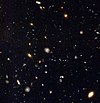 |
Hubble Deep Field South | 1998 | 995 |
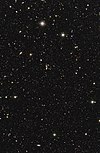 |
Chandra Deep Field South | 1999–2000 | 11 |
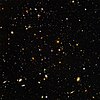 |
Hubble Ultra-Deep Field | 2003–2004 | 808 |
| Extended Groth Strip | 2004–2005 | over 500 | |
 |
Cosmic Assembly Near-infrared Deep Extragalactic Legacy Survey (CANDELS) | 2011 | |
 |
ESO’s VLT and the SINFONI instrument[2] | 2012 | |
 |
Hubble eXtreme Deep Field | 2012 | |
 |
Hubble Ultra-Deep Field (UV/VIS/NIR) | 2014 | |
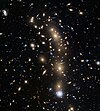 |
Frontier Fields MACS J0416.1-2403[3] | 2015 | |
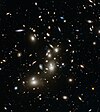 |
Frontier Fields Abell 2744[4] | 2015 | |
 |
Frontier Fields MACS J0717.5+3745 | 2015 | |
 |
Frontier Fields MACS J1149.5+2223[5] | 2015 | |
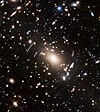 |
Frontier Fields Abell S1063[6] | 2016 | |
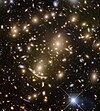 |
Frontier Fields Abell 370[7] | 2017 | |
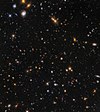 |
Frontier Fields Abell 370 parallel field[8] | 2017 | |
 |
Hubble Deep UV (HDUV) Legacy Survey[9] | 2018 | |
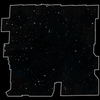 |
Hubble Legacy Field[1] | 2019 | 7,500 |
See also[]
References[]
| Wikimedia Commons has media related to Deep fields. |
- ^ a b "Hubble Assembles Wide View of the Distant Universe". www.spacetelescope.org. Retrieved 3 May 2019.
- ^ "The Feeding Habits of Teenage Galaxies". ESO Press Release. Retrieved 16 March 2012.
- ^ Vogel, Tracy. "MACS J0416 Data is Complete". Frontier Fields. Retrieved 24 Nov 2015.
- ^ "Meet the Frontier Fields: Abell 2744". Frontier Fields. Retrieved 24 Nov 2015.
- ^ "A galactic gathering". Retrieved 23 May 2016.
- ^ "Space... the final frontier". www.spacetelescope.org. Retrieved 25 July 2016.
- ^ "Abell 370". spacetelescope.org. Retrieved 21 Jun 2018.
- ^ "Abell 370 parallel field". spacetelescope.org. Retrieved 21 Jun 2018.
- ^ Jenkins, Ann; Villard, Ray; Oesch, Pascal; Montes, Mireia; Hille, Karl (16 August 2018). "NASA - Hubble Paints Picture of the Evolving Universe". NASA. Retrieved 17 August 2018.
- ^ {{}}
- Astronomy image articles
- Astronomical surveys
- Image galleries


